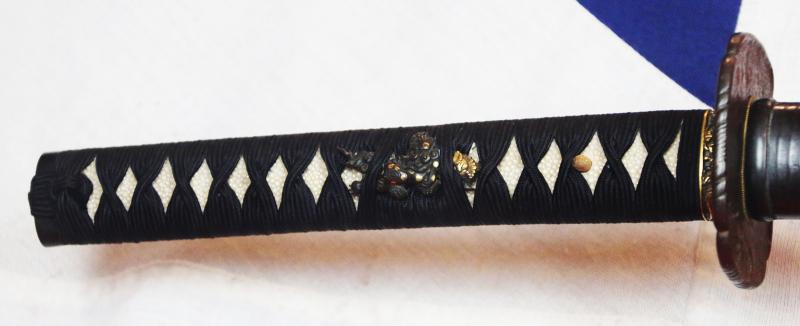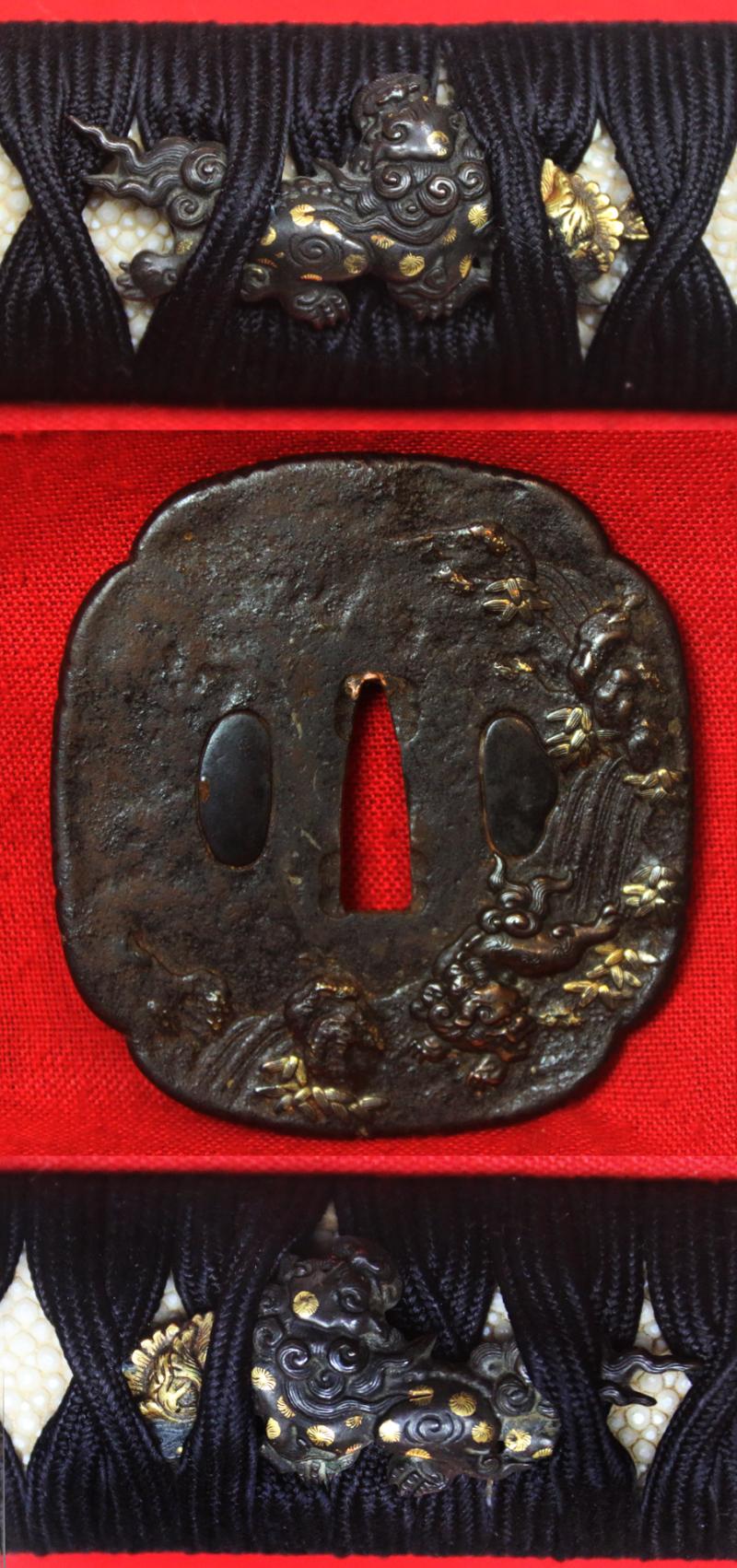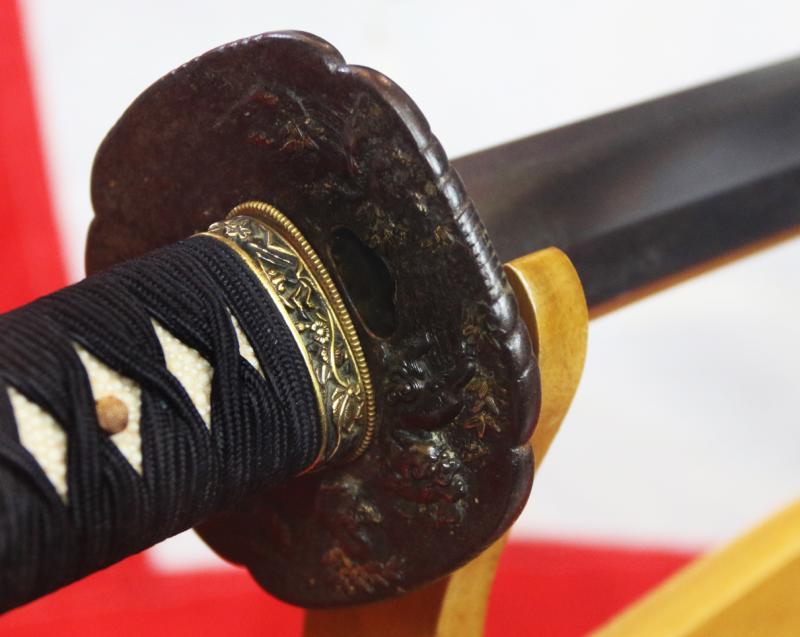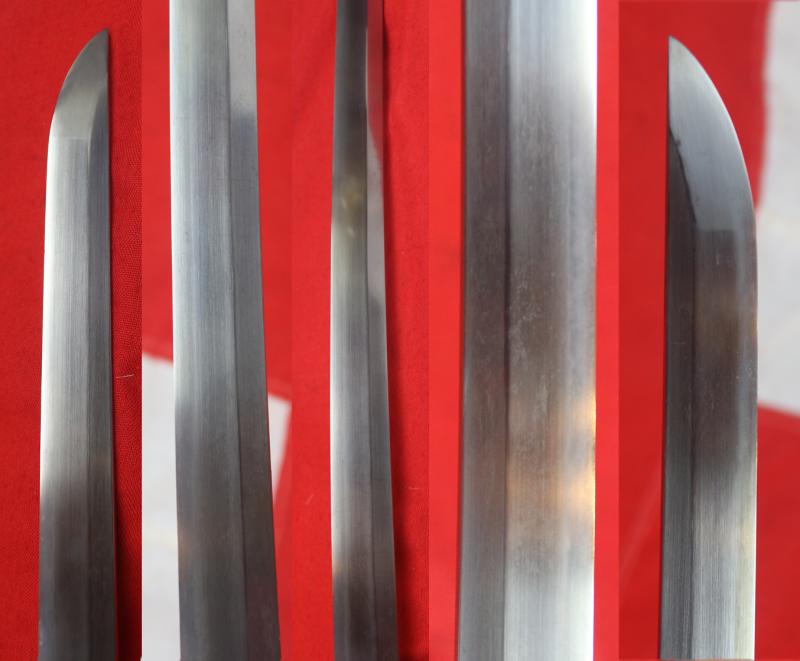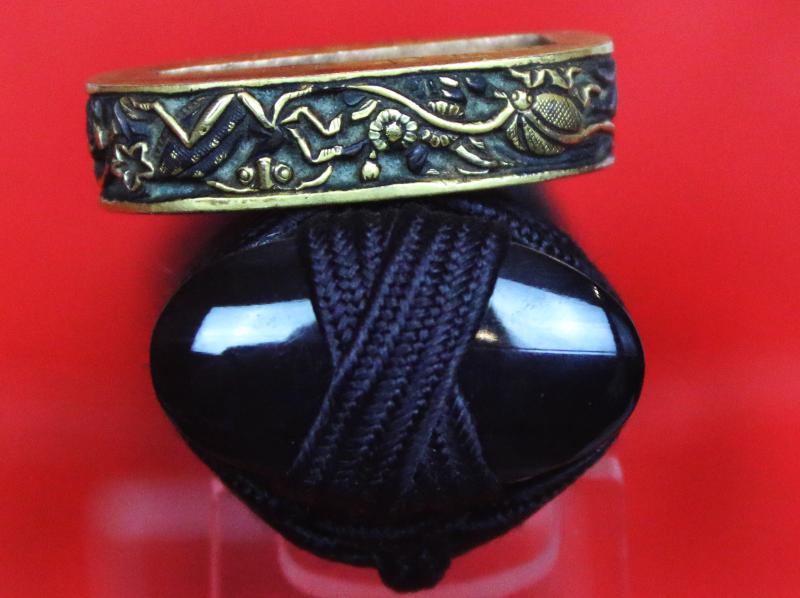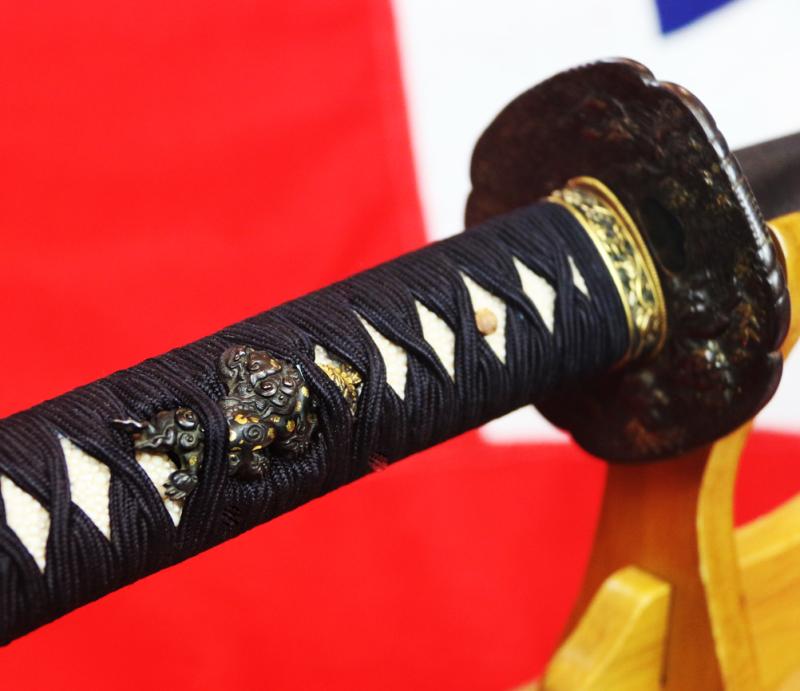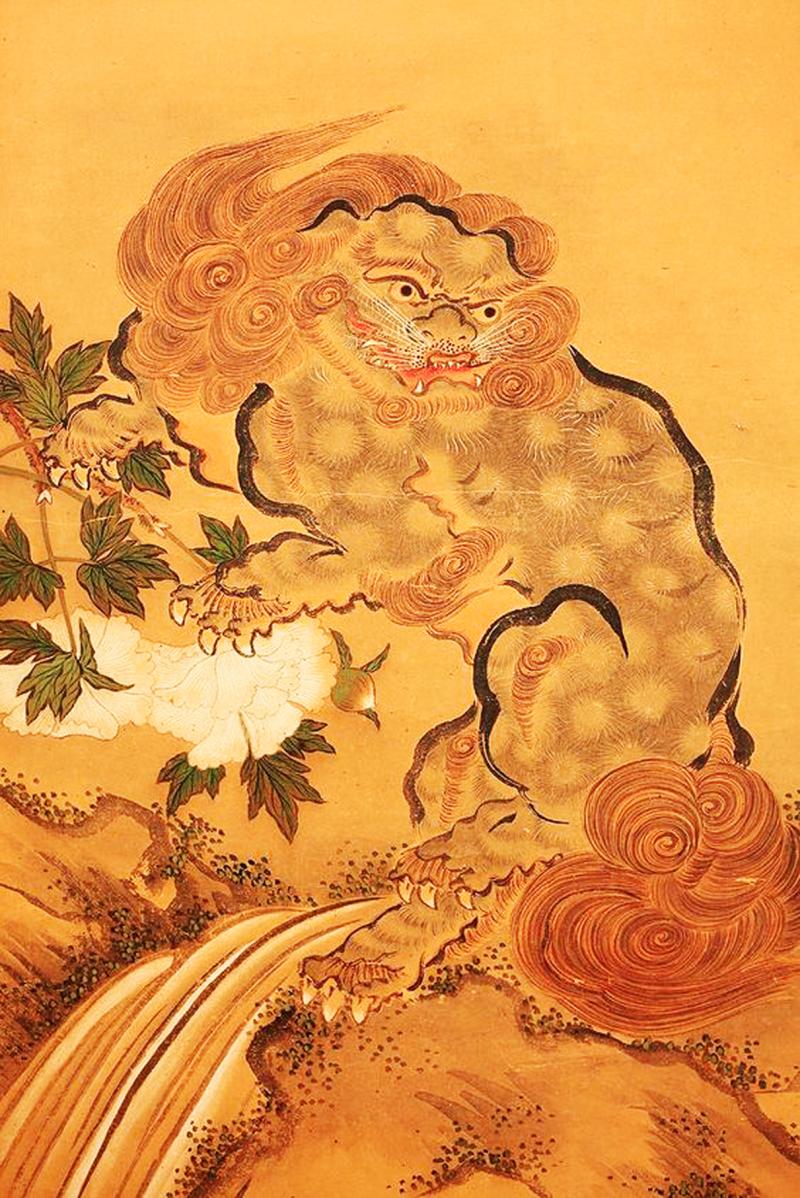A Wonderful Shinto 'Shishi' Katana With All Original Edo Period Koshirae of Exemplary Museum Grade Fittings based on The Mythical Protectors of The Shinto Shrines, the Shishi Lion-Dogs
A typical example of a very fine katana of a seieibushi (elite samurai) traditionally the Highest rank of elite samurai. Circa 1670, with a most fine hon-zukuri blade form with suguha hamon, mumei; and a wonderful iron sumiiri kakugata tsuba with shishiaibori decoration of a shishi lion dog below a waterfall, with complimentary matching mino-goto fuchi, fabulous large shishi lion-dog menuki in shakudo with pure gold inlay highlights; set within its original beautiful Edo period saya of a combination of ribbed and lobster-scale urishi lacquer. The fuchi is Goto school of deep takebori of gold and shakudo catydids and insects, with a carved polished buffalo horn kashira. Tradition black tsuka Ito wrapped over the fabulous menuki on the samegawa {giant rayskin}
Shishi (or Jishi) is translated as "lion” but it can also refer to a deer or dog with magical properties and the power to repel evil spirits. A pair of shishi traditionally stand guard outside the gates of Japanese Shinto shrines and Buddhist temples, although temples are more often guarded by two Nio Protectors. The Shishi (like the Nio) are traditionally depicted in pairs, one with mouth open and one with mouth shut. The opened/closed mouth relates to Ah (open mouth) and Un (closed mouth). “Ah" is the first sound in the Japanese alphabet, while "N" (pronounced "un") is the last. These two sounds symbolize beginning and end, birth and death, and all possible outcomes (from alpha to omega) in the cosmic dance of existence. The first letter in Sanskrit is "Ah" as well, but the last is "Ha." Nonetheless, the first and last sounds produced by the mouth are "Ah" and "M." The Sanskrit "m" and the Japanese "n" sound exactly the same when hummed with mouth closed. The spiritual Sanskrit terms AHAM and AUM thus encapsulate the first letter-sound (mouth open) and the final sound (mouth closed). Others say the open mouth is to scare off demons, and the closed mouth to shelter and keep in the good spirits. The circular object often shown beneath their feet is the Tama 玉, or sacred Buddhist jewel, a symbol of Buddhist wisdom that brings light to darkness and holds the power to grant wishes.
The Incredible Story of Japanese Lacquer on Samurai Swords Scabbards, called Saya
Japanese lacquer, or urushi, is a transformative and highly prized material that has been refined for over 7000 years.
Cherished for its infinite versatility, urushi is a distinctive art form that has spread across all facets of Japanese culture from the tea ceremony to the saya scabbards of samurai swords
Japanese artists created their own style and perfected the art of decorated lacquerware during the 8th century. Japanese lacquer skills reached its peak as early as the twelfth century, at the end of the Heian period (794-1185). This skill was passed on from father to son and from master to apprentice.
Some provinces of Japan were famous for their contribution to this art: the province of Edo (later Tokyo), for example, produced the most beautiful lacquered pieces from the 17th to the 18th centuries. Lords and shoguns privately employed lacquerers to produce ceremonial and decorative objects for their homes and palaces.
The varnish used in Japanese lacquer is made from the sap of the urushi tree, also known as the lacquer tree or the Japanese varnish tree (Rhus vernacifera), which mainly grows in Japan and China, as well as Southeast Asia. Japanese lacquer, 漆 urushi, is made from the sap of the lacquer tree. The tree must be tapped carefully, as in its raw form the liquid is poisonous to the touch, and even breathing in the fumes can be dangerous. But people in Japan have been working with this material for many millennia, so there has been time to refine the technique!
Flowing from incisions made in the bark, the sap, or raw lacquer is a viscous greyish-white juice. The harvesting of the resin can only be done in very small quantities.
Three to five years after being harvested, the resin is treated to make an extremely resistant, honey-textured lacquer. After filtering, homogenization and dehydration, the sap becomes transparent and can be tinted in black, red, yellow, green or brown.
Once applied on an object, lacquer is dried under very precise conditions: a temperature between 25 and 30°C and a humidity level between 75 and 80%. Its harvesting and highly technical processing make urushi an expensive raw material applied in exceptionally fine successive layers, on objects such as bowls or boxes.After heating and filtering, urushi can be applied directly to a solid, usually wooden, base. Pure urushi dries into a transparent film, while the more familiar black and red colours are created by adding minerals to the material. Each layer is left to dry and polished before the next layer is added. This process can be very time-consuming and labor-intensive, which contributes to the desirability, and high costs, of traditionally made lacquer goods. The skills and techniques of Japanese lacquer have been passed down through the generations for many centuries. For four hundred years, the master artisans of Zohiko’s Kyoto workshop have provided refined lacquer articles for the imperial household
Blade 28.5 inches long from tsuba to tip. Overall 40.5 inches long in saya.
As once told to us by an esteemed regular visitor to us here in our gallery, and the same words that are repeated in his book;
“In these textures lies an extraordinary and unique feature of the sword - the steel itself possesses an intrinsic beauty. The Japanese sword has been appreciated as an art object since its perfection some time during the tenth century AD. Fine swords have been more highly prized than lands or riches, those of superior quality being handed down from generation to generation. In fact, many well-documented swords, whose blades are signed by their makers, survive from nearly a thousand years ago. Recognizable features of the blades of hundreds of schools of sword-making have been punctiliously recorded, and the study of the sword is a guide to the flow of Japanese history.”
Victor Harris
Curator, Assistant Keeper and then Keeper (1998-2003) of the Department of Japanese Antiquities at the British Museum. He studied from 1968-71 under Sato Kenzan, Tokyo National Museum and Society for the Preservation of Japanese Swords
Every single item from The Lanes Armoury is accompanied by our unique Certificate of Authenticity. Part of our continued dedication to maintain the standards forged by us over the past 100 years of our family’s trading
Code: 25304
8975.00 GBP


